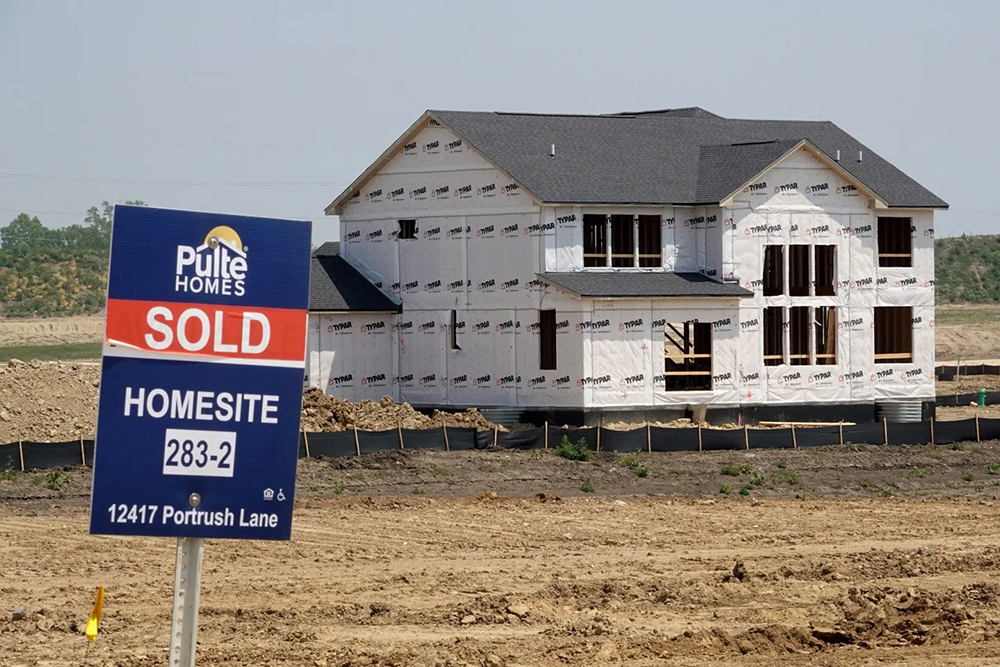
俗话说,历史往往会重演。根据高盛集团(Goldman Sachs)的分析,目前房地产市场的情况正是如此——只不过在某些方面,它实际上比2008年的灾难性崩盘还要糟糕。
抵押贷款利率达到了二十多年来的最高水平,接近7.5%,而且由于几十年来房屋建设不足,房屋供不应求,房价持续攀升。美国人口普查局(Census Bureau)的数据显示,到2023年第二季度,美国房屋的平均售价接近50万美元,几乎是2008年房地产泡沫破裂时房价的两倍。
高盛集团常务董事罗杰·阿什沃斯(Roger Ashworth)在16年后回顾了引发大衰退的房地产崩盘,发现目前大多数指标都处于"更为有利的地位"——但主要例外是负担能力。
他在周二发布的一份信贷策略研究报告中写道:“虽然房地产和更普遍的消费基本面如今要强劲得多,但增量买家的负担能力比2006年崩盘前的峰值还要糟糕。即使整体经济没有受到任何负面冲击(导致市场上房屋供应过剩或失业率上升),我们仍然预计房价将以缓慢的速度上涨。”
这家华尔街银行并非唯一一家对住房成本做出悲观评估的银行。根据亚特兰大联邦储备银行的房屋所有权负担能力监测,住房负担能力比2006年的水平更糟糕。该监测追踪的因素包括房价中位数、收入中位数、抵押贷款利率、每月本息支付额以及用于抵押贷款的平均收入百分比。截至2023年7月,住房负担能力同比下降了近8个百分点,仍比人们普遍接受的门槛低31个百分点以上。
阿什沃斯在题为《美国房市崩盘比16年前的情况更糟糕》的论文中预测,到今年年底,我们将看到房价上涨1.8%,到2024年底将上涨3.5%。阿什沃思十多年来一直在研究抵押贷款支持证券和房地产市场,最近在花旗银行(Citi)工作。据eFinancialCareers网站报道,他于今年7月加入高盛集团。阿什沃斯没有回应《财富》杂志就这篇研究论文作进一步评论的请求。
尽管人们仍有理由担心住房负担能力问题,但自2008年房利美(Fannie Mae)和房地美(Freddie Mac)被美国政府托管以来,情况发生了很大变化——如今房地产市场面临的主要挑战也与以往不同。
首先,二十年前,零首付抵押贷款和套现房屋净值等产品帮助更多美国人购买房产,因此,在上一次危机时推高了房地产价格。如今,房价之所以居高不下,是因为待售房屋数量大大减少。事实上,住房库存水平已接近历史最低点。根据Realtor.com的数据,在2018年9月至2023年9月期间,市场上的平均房屋数量下降了60%,活跃房源降至70万套以下。
阿什沃斯写道:“目前的房屋库存较低有助于解释为什么尽管我们所处的可负担性环境充满挑战,但房价似乎仍有弹性。”但在2004年至2009年期间,房屋供应量开始增长,而房价升值放缓,他指出:“不仅房屋的月供应量处于高位,甚至在失业开始之前,面临止赎的借款人的'影子'库存也在增加。”
如今,我们看到抵押贷款利率和房价同步攀升,这对那些发现自己被高房价挤出市场的潜在购房者来说是一场残酷的风暴。在上次危机期间,较高的抵押贷款利率开始转化为疲软的房价,但今天的情况并非如此。
房地美首席经济学家萨姆·卡特(Sam Khater)在9月29日发布的一份声明中说:“与千禧年之初的情况不同的是,今天的房价与抵押贷款利率同步上涨,这主要是由于低库存造成的。这些不利因素导致买家和卖家都在等待更好的环境。”
遗憾的是,阿什沃斯和许多其他房地产经济学家和专家一样,并不指望这些潜在买家能在短期内进行更好的交易。在房屋供应量没有增加、失业率没有上升、抵押贷款利率没有下降的情况下,高盛集团坚持其预测,即房价将在明年继续攀升。
阿什沃斯写道:“现在,利率已经逆转并大幅走高,与2004-07年期间的情况相比,增量购房者的负担能力面临更大挑战。我们仍然预计,房价在中期内将以缓慢的速度上涨。”(财富中文网)
译者:中慧言-王芳
俗话说,历史往往会重演。根据高盛集团(Goldman Sachs)的分析,目前房地产市场的情况正是如此——只不过在某些方面,它实际上比2008年的灾难性崩盘还要糟糕。
抵押贷款利率达到了二十多年来的最高水平,接近7.5%,而且由于几十年来房屋建设不足,房屋供不应求,房价持续攀升。美国人口普查局(Census Bureau)的数据显示,到2023年第二季度,美国房屋的平均售价接近50万美元,几乎是2008年房地产泡沫破裂时房价的两倍。
高盛集团常务董事罗杰·阿什沃斯(Roger Ashworth)在16年后回顾了引发大衰退的房地产崩盘,发现目前大多数指标都处于"更为有利的地位"——但主要例外是负担能力。
他在周二发布的一份信贷策略研究报告中写道:“虽然房地产和更普遍的消费基本面如今要强劲得多,但增量买家的负担能力比2006年崩盘前的峰值还要糟糕。即使整体经济没有受到任何负面冲击(导致市场上房屋供应过剩或失业率上升),我们仍然预计房价将以缓慢的速度上涨。”
这家华尔街银行并非唯一一家对住房成本做出悲观评估的银行。根据亚特兰大联邦储备银行的房屋所有权负担能力监测,住房负担能力比2006年的水平更糟糕。该监测追踪的因素包括房价中位数、收入中位数、抵押贷款利率、每月本息支付额以及用于抵押贷款的平均收入百分比。截至2023年7月,住房负担能力同比下降了近8个百分点,仍比人们普遍接受的门槛低31个百分点以上。
阿什沃斯在题为《美国房市崩盘比16年前的情况更糟糕》的论文中预测,到今年年底,我们将看到房价上涨1.8%,到2024年底将上涨3.5%。阿什沃思十多年来一直在研究抵押贷款支持证券和房地产市场,最近在花旗银行(Citi)工作。据eFinancialCareers网站报道,他于今年7月加入高盛集团。阿什沃斯没有回应《财富》杂志就这篇研究论文作进一步评论的请求。
尽管人们仍有理由担心住房负担能力问题,但自2008年房利美(Fannie Mae)和房地美(Freddie Mac)被美国政府托管以来,情况发生了很大变化——如今房地产市场面临的主要挑战也与以往不同。
首先,二十年前,零首付抵押贷款和套现房屋净值等产品帮助更多美国人购买房产,因此,在上一次危机时推高了房地产价格。如今,房价之所以居高不下,是因为待售房屋数量大大减少。事实上,住房库存水平已接近历史最低点。根据Realtor.com的数据,在2018年9月至2023年9月期间,市场上的平均房屋数量下降了60%,活跃房源降至70万套以下。
阿什沃斯写道:“目前的房屋库存较低有助于解释为什么尽管我们所处的可负担性环境充满挑战,但房价似乎仍有弹性。”但在2004年至2009年期间,房屋供应量开始增长,而房价升值放缓,他指出:“不仅房屋的月供应量处于高位,甚至在失业开始之前,面临止赎的借款人的'影子'库存也在增加。”
如今,我们看到抵押贷款利率和房价同步攀升,这对那些发现自己被高房价挤出市场的潜在购房者来说是一场残酷的风暴。在上次危机期间,较高的抵押贷款利率开始转化为疲软的房价,但今天的情况并非如此。
房地美首席经济学家萨姆·卡特(Sam Khater)在9月29日发布的一份声明中说:“与千禧年之初的情况不同的是,今天的房价与抵押贷款利率同步上涨,这主要是由于低库存造成的。这些不利因素导致买家和卖家都在等待更好的环境。”
遗憾的是,阿什沃斯和许多其他房地产经济学家和专家一样,并不指望这些潜在买家能在短期内进行更好的交易。在房屋供应量没有增加、失业率没有上升、抵押贷款利率没有下降的情况下,高盛集团坚持其预测,即房价将在明年继续攀升。
阿什沃斯写道:“现在,利率已经逆转并大幅走高,与2004-07年期间的情况相比,增量购房者的负担能力面临更大挑战。我们仍然预计,房价在中期内将以缓慢的速度上涨。”(财富中文网)
译者:中慧言-王芳
They say that history tends to repeat itself. That’s happening in the housing market right now—except it’s actually worse than the disastrous crash of 2008 in some ways, according to a Goldman Sachs analysis.
Mortgage rates are at their highest levels in more than two decades at nearly 7.5%, and home prices continue to creep upward because of decades of underbuilding and the resultant lack of houses. For the second quarter of 2023, the average sale price in the U.S. hit nearly $500,000, according to the Census Bureau, nearly double the price of homes at the time that the housing bubble burst in 2008.
Roger Ashworth, a managing director at Goldman Sachs, looked at the housing crash that sparked the Great Recession 16 years later, and found most things in a “much stronger position”—with the major exception of affordability.
“While housing and more generally consumer fundamentals are in a much stronger position today, affordability for the incremental buyer is worse than it was at the peak in 2006 before the crash,” he wrote in a credit strategy research paper released Tuesday. “Absent any negative shocks to the broader economy that would either boost excess supply of homes on the market or fuel an uptick in unemployment, we continue to expect home prices to rise at a slow pace.”
The Wall Street bank is far from alone in its withering assessment of housing costs. The Atlanta Fed found that housing affordability has deteriorated beyond 2006 levels in its Home Ownership Affordability Monitor, which tracks factors including median home prices, median income, mortgage rate, monthly principal and interest payments, and the average percentage of income spent on mortgages. As of July 2023, housing affordability had dropped nearly eight percentage points year-over-year—and remains more than 31 percentage points below the threshold considered widely accessible.
By the end of this year, we’ll see home prices rise by 1.8%, with a 3.5% increase by the end of 2024, Ashworth predicted in the paper titled, “U.S. Housing market crash turns not-so-sweet 16.” Ashworth has been studying mortgage-backed securities and the real estate market for more than a decade, most recently with Citi. He joined Goldman in July, according to eFinancialCareers. Ashworth did not respond to Fortune’s request for further comment on the research paper.
Although there’s still reason to be concerned about housing affordability, a lot has changed since 2008, when Fannie Mae and Freddie Mac were placed under conservatorship by the U.S. government—and the major challenges facing the housing market today differ from before.
For one, two decades ago, products like zero-down-payment mortgages and taking out cash from a home’s equity helped more Americans buy property, boosting real estate prices at the time of the last crisis. Today, prices are high because there are much fewer homes for sale. Indeed, housing housing inventory levels are near historic lows. Between September 2018 and September 2023, the average number of homes on the market dropped a whopping 60% to below 700,000 active listings, according to Realtor.com.
“The current low home inventory could help explain why home prices appear to be resilient despite the challenging affordability environment we find ourselves in,” Ashworth wrote. But in the 2004 to 2009 period, home supply started growing while home price appreciation slowed, he noted: “Not only was the months’ supply of homes high, there was also a buildup in ‘shadow’ inventory of homes of borrowers facing foreclosure even before job losses started.”
Today, we’re seeing mortgage rates and home prices climb in tandem—a brutal storm for would-be homebuyers who find themselves priced out. During the last crash, higher loan payments started to translate into weaker home prices, which isn’t the case today.
“[U]nlike the turn of the millennium, house prices today are rising alongside mortgage rates, primarily due to low inventory,” Sam Khater, Freddie Mac’s chief economist, said in a statement released Sept. 29. “These headwinds are causing both buyers and sellers to hold out for better circumstances.”
Unfortunately for those would-be buyers, Ashworth, along with many other real estate economists and experts, doesn’t expect better deals any time soon. Without a boost in home supply, an uptick in unemployment, or a drop in mortgage rates, Goldman holds to its projection that home prices will continue to climb into next year.
“Now that interest rates have reversed course and are now far higher, affordability for the incremental home buyer is more challenged than during the 2004-07 period,” Ashworth wrote. “We continue to expect home prices to rise at a slow pace over the medium term.”






